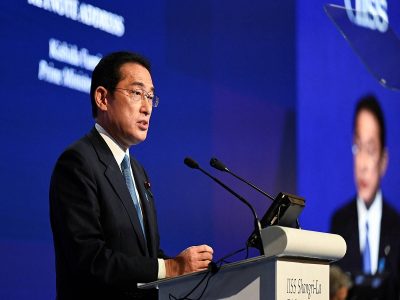Japan Just Outlined Its Unofficial Remilitarization Plans

All Global Research articles can be read in 51 languages by activating the “Translate Website” drop down menu on the top banner of our home page (Desktop version).
To receive Global Research’s Daily Newsletter (selected articles), click here.
Visit and follow us on Instagram, Twitter and Facebook. Feel free to repost and share widely Global Research articles.
***
Everyone remembers what happened the last time that the self-professed “land of the rising sun” tried to become the most powerful country in the continent even though its Prime Minister, just like all of his predecessors, likes to pretend that the Second World War never happened. Keeping with the sun analogy, it’s quickly setting on the declining American unipolar hegemon so only the foolish would tie their prosperity and security to that former superpower.
Japanese Prime Minister Fumio Kishida gave a speech at Singapore’s Shangri-La Dialogue last Friday where he outlined his constitutionally pacifist country’s unofficial remilitarization plans. This island nation isn’t allowed to prepare for war after sparking the Second World War in Asia, yet its American overlord isn’t just turning a blind eye towards its military buildup, but is actively supporting it in order to advance its anti-Chinese “containment” plans by proxy.
Kishida started off by lying about the situations in the East and South China Seas, strongly implying that China unilaterally changed their status quo where when it was actually his own country and the nearby ones respectively that are responsible for the present uncertainty. They destabilized those maritime regions on the false pretexts of upholding the subjectively defined so-called “rules-based order” that their US ally never tires of talking about but which is in reality nothing more than double standards.
In response to his twisted interpretation of events, the Japanese Prime Minister unveiled what he arrogantly described as the so-called “Kishida Vision for Peace”. One of its pillars is upholding the “rules-based order” that was just described, to which end he threatened vague consequences for those countries that go against it. Given the context of his speech and what he’d earlier implied about the East and South China Seas, it should be taken for granted that he was referring to China.
Kishida also disturbingly hinted at supporting regional regime change campaigns when declaring that “respect for human rights is also critical, as is a democratic political system that reflects people’s free will and diversity”, though it remains unclear how Japan might actually participate in them. Moving along, this backdrop sets the basis for articulating the security dimension of his misleadingly described “Vision for Peace”, which places a lot of emphasis on the Quad and other multilateral cooperation.
He announced that Japan will strengthen at least 20 countries’ maritime law enforcement capabilities over the next three years, which will include training over 800 maritime security personnel and “more than 1,500 personnel in the fields of the rule of law and governance”. After repeating his fearmongering phrase that “Ukraine today may be East Asia tomorrow”, Kishida then declared that “we will set out a new National Security Strategy by the end of this year.”
According to him, this will “fundamentally reinforce Japan’s defense capabilities within the next five years and secure substantial increase of Japan’s defense budget needed to effect it.” He added that “we will not rule out any options, including so-called ‘counterstrike capabilities’”, which arguably contradicts his officially pacifist country’s constitution. Furthermore, Kishida plans to “work closely with like-minded partners in Europe and Asia towards the conclusion of [Reciprocal Access Agreements].”
These refer to the pacts that it recently reached with Australia and agreed in principle to clinch with the UK, both of which comprise two of the new anti-Chinese AUKUS alliance’s three members, to more closely coordinate their military activities. In practice, it’ll likely result in their navies regularly docking in Japanese ports. Upon its planned expansion to “like-minded partners in Europe and Asia”, this means that more foreign navies will likely transit through the East and South China Seas en route to Japan.
The problem with this is that it implies that they’ll also threaten to unilaterally violate China’s sovereign maritime territory through more so-called “freedom of navigation patrols” (FONOPs), which will escalate regional tensions but be blamed on China on the false basis that it’s “violating the rules-based order”. Altogether, it’s clear that Japan is positioning itself to become a leading antagonist in the Asian theater of what many are already referring to as the New Cold War.
The sincerely peace-loving nations of the world, which excludes Japan despite Kishida dishonestly describing his country as such midway through his speech, should join together to oppose Japan’s remilitarization. Everyone remembers what happened the last time that the self-professed “land of the rising sun” tried to become the most powerful country in the continent even though its Prime Minister, just like all of his predecessors, likes to pretend that the Second World War never happened.
Keeping with the sun analogy, it’s quickly setting on the declining American unipolar hegemon so only the foolish would tie their prosperity and security to that former superpower. The US is desperately trying to stir chaos across the world in a dangerous gamble to exploit the resultant unrest with a view towards reasserting its lost regional influence. Kishida envisions Japan playing a key role in this, which will turn his island nation into a pawn of US Hybrid Wars by making it the agent of Asian instability.
*
Note to readers: Please click the share buttons above or below. Follow us on Instagram, Twitter and Facebook. Feel free to repost and share widely Global Research articles.
This article was originally published on OneWorld.

